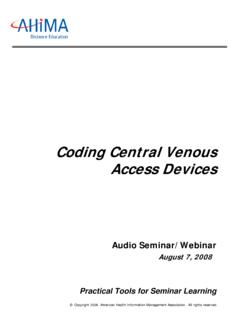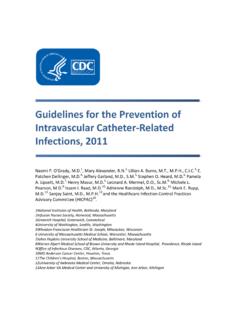Transcription of Central Vascular Access Drvice Insertion - Queensland Health
1 The State of Queensland ( Queensland Health ), 2011. Permission to reproduce should be sought from (Affix identification label here). URN: Family name: Central Vascular Access Device Given name(s): Insertion Address: Date of birth: Sex: M F I. Facility: A. Interpreter / cultural needs The device may become blocked and need medications to unblock or may need to be An Interpreter Service is required? Yes No removed. If Yes, is a qualified Interpreter present? Yes No (Tunnelled and Non-tunnelled catheters only) The A Cultural Support Person is required? Yes No device may be accidentally removed if pulled or If Yes, is a Cultural Support Person present? Yes No tugged on. Failure of local anaesthetic which may require a B. Procedure further injection of anaesthetic or a different The following will be performed (Doctor/doctor method of anaesthesia may be used. delegate to document include site and/or side where Nerve damage, is usually temporary, and should relevant to the procedure) get better over a period of time.
2 Permanent nerve damage is rare.. Less common risks and complications include: .. Infection at the skin, requiring antibiotics and/or A Central Vascular Access Device is used to give you further treatment. medication directly into your blood stream without Infection in the device, requiring the device to be DO NOT WRITE IN THIS BINDING MARGIN. having to repeatedly insert a needle into your vein. removed. There are many different types of devices. The Pneumothorax, a collection of air around the device that you have inserted is dependant on the lining of the lungs. This usually resolves by itself type and length of treatment required. but sometimes may require a tube to be inserted Non-Tunnelled Catheter such as Vascath and into the chest. Central line; Damage to surrounding structures such as blood Tunnelled Catheter such as Hickman Catheter vessels, organs and muscles, requiring further and Permacath Dialysis Catheter ; treatment.
3 PROCEDURAL CONSENT FORM. Implantable Port such as Portacath and Failure to gain Access to the vein. This may Infusaport . require a second attempt from a different location. This procedure will require an injection of local Blood clot blocking the vein, may require anaesthetic and a sedation anaesthetic. medication to treat. An allergy to injected drugs, requiring further C. Risks of the procedure treatment. In recommending a Central Venous Access Device, The procedure may not be possible due to the doctor believes the benefits to you from having medical and/or technical reasons. this procedure exceed the risks involved. Rare risks and complications include: The risks and complications with this procedure and Injected medications may leak outside of the vein with having a device can include but are not limited to under the skin and into tissue, this may require the following. treatment. Common risks and complications include: A fast or irregular heart beat.
4 This usually Minor pain, bruising and/or infection from the IV resolves on it's own but sometimes may need cannula. This may require treatment with further treatment. antibiotics. The catheter tip may move from the original - 03/2011. Pain or discomfort at the Insertion site. This may placement. The device may need to be removed. require medication. An air bubble enters the blood stream. This can Bleeding or bruising may occur. This is usually travel to the heart causing a heart attack or to the stopped by applying further pressure and/or ice to brain causing a stroke. the puncture site. This is more common if you An increased lifetime cancer risk due to the take Aspirin, Warfarin, Clopidogrel (Plavix and exposure to x-rays. Iscover) or Dipyridamole (Persantin and Seizures and/or cardiac arrest due to local Asasantin). anaesthetic toxicity. SW9240. The device may become kinked and need Death as a result of this procedure is very rare.
5 Repositioning or removal. If sedation is given extra risks include: faintness or dizziness, especially when you start to move around Page 1 of 2 Continues over page . (Affix identification label here). URN: Family name: Central Vascular Access Device Given name(s): Insertion Address: Date of birth: Sex: M F I. Facility: fall in blood pressure I request to have the procedure nausea and vomiting Name of Patient: .. weakness Signature: .. an existing medical condition getting worse Date: .. heart and lung problems such as heart attack or vomit in the lungs causing pneumonia. This may Patients who lack capacity to provide consent require emergency treatment Consent must be obtained from a substitute decision maker/s in the order below. stroke resulting in brain damage. Does the patient have an Advance Health Directive D. Patient consent (AHD)? I acknowledge that the doctor/doctor delegate has Yes Location of the original or certified copy of the AHD: explained the proposed procedure.
6 I understand;. the risks and complications, including the risks No Name of Substitute Decision Maker/s: .. that are specific to me. DO NOT WRITE IN THIS BINDING MARGIN. the sedation/anaesthetic required for this Signature: .. procedure. I understand the risks, including the Relationship to patient: .. risks that are specific to me. Date: .. PH No: .. that no guarantee has been made that the procedure will improve my condition even though Source of decision making authority (tick one): it has been carried out with due professional care. Tribunal-appointed Guardian if immediate life-threatening events happen Attorney/s for Health matters under Enduring Power during the procedure, they will be treated based of Attorney or AHD. on my discussions with the doctor/doctor delegate Statutory Health Attorney or my Acute Resuscitation Plan. If none of these, the Adult Guardian has provided a doctor/doctor delegate undergoing further consent.
7 Ph 1300 QLD OAG (753 624). training may conduct this procedure. I have been given the following Patient E. Doctor/delegate Statement Information Sheet/s: I have explained to the patient all the above points Central Vascular Access Device under the Patient Consent section (D) and I am of Insertion the opinion that the patient/substitute decision- maker has understood the information. I was able to ask questions and raise concerns Name of Doctor/delegate: .. with the doctor/doctor delegate about the Designation:.. proposed procedure and its risks. My questions and concerns have been discussed and Signature: .. Date .. answered to my satisfaction. I understand I have the right to change my mind F. Interpreter's statement at any time including after I have signed this form I have given a sight translation in but, preferably following a discussion with my doctor/doctor delegate.. I understand that image/s or video footage may (state the patient's language here) of the consent form and assisted in the provision of any verbal and written be recorded as part of and during my procedure information given to the patient/parent or and that these image/s or video/s will assist the guardian/substitute decision-maker by the doctor.
8 Doctor to provide appropriate treatment. Name of I understand that Queensland Health may release Interpreter: .. my relevant de-identified information obtained Signature: .. Date .. from this and related procedures for education and training of Health professionals. 03/2011 - On the basis of the above statements, Page 2 of 2. The State of Queensland ( Queensland Health ), 2011. Permission to reproduce should be sought from Consent Information - Patient Copy Central Vascular Access Device Insertion 1. What is a Central Vascular Access may alter the affects of the sedation anaesthetic. Device? If you have a drug habit please tell your doctor. A Central Vascular Access Device is used to give you medication directly into your blood stream without 5. During the procedure having to repeatedly insert a needle into your vein. For All Devices There are many different types of devices. The device A fine needle (IV cannula) will be inserted into a vein that you have inserted is dependant on the type and in your arm.
9 Length of treatment required. Ultrasound will be used to look at the veins at the base Types of devices include: of your child's neck (sometimes a vein in their groin is a) Non-Tunnelled Catheter such as Vascath and used). A suitable vein for the catheter will be selected. Central line; Local anaesthetic and sedation will be injected. b) Tunnelled Catheter such as Hickman Catheter A small cut is made in the skin over the vein. and Permacath Dialysis Catheter ;. Using ultrasound as a guide the needle will be c) Implantable Port such as Portacath and inserted into your vein. You may be asked to hold Infusaport . your breath for several seconds while the catheter is inserted. The tip of the catheter will be positioned 2. Will there be any discomfort, is any using x-ray guidance in a major blood vessel next to anaesthetic needed? the heart. The catheter does not go into your heart. This procedure will require the injection of a local When the catheter is in the correct place a chest x-ray anaesthetic and a sedation anaesthetic.
10 Will be taken to confirm its placement. 3. What is sedation? Non-Tunnelled Catheter Sedation is the use of drugs that give you a sleepy- The catheter is inserted directly into the vein and is like' feeling. It makes you feel very relaxed during a held in place with sutures and a dressing. This type of procedure that may be otherwise unpleasant or catheter can stay in for about a week. painful. You may remember some or little about what has occurred during the procedure. Tunnelled Catheter This procedure may only have a light sedation. You A small cut is made in the skin on your chest and the need to be able to fully co-operate at times by holding catheter is pushed (tunnelled) under your skin until it your breath when instructed by the doctor. reaches the vein to be entered. Sedation is generally very safe but has a risk with side Tunnelled Catheters are held in place with sutures. effects and complications.














